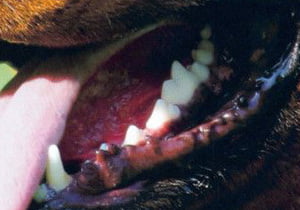How sweet is your dog’s breath? What is commonly known as doggy breath seems synonymous with dog ownership. Yet doggy breath should be neither ignored nor taken for granted. Though some believe doggy breath to be normal, it is often the first indication that owners should sit up and take notice. Sometimes, horrific doggy breath signals the onset of canine periodontal disease.
Despite its common occurrence, canine periodontal disease should not be considered normal. As with humans, periodontal disease can lead to secondary health issues. As many dog owners have discovered, gum infections can cause the infamous doggy breath, tooth loss and infections that can threaten the overall health of affected dogs. To avoid these problems, all dog owners should learn to recognize the onset and stages of canine periodontal disease.
Canine Periodontal Disease Terms
Pet care specialists may use terms unfamiliar to the lay person. The three most commonly used are
Gingiva: more commonly known as gums, or area surrounding the teeth,
Gingivitis: inflammation of the gingiva, and
Periodontium: bone, tissue and gum supporting a tooth
When the gingiva and periodontium become compromised by plaque and bacteria, gingivitis is the result. It should be noted that gingivitis is often a precursor to canine periodontal disease, but gingivitis and periodontal disease are generally considered separate conditions, the one a precursor to the other.
Plaque – the precursor
Many dog owners recognize the hardening of plaque, which is formed by food particles. This plaque becomes tartar, that yellow substance that ruins the pearly white appearance of our dogs’ smiles. While the appearance of plaque is annoying for its ugly appearance, dog owners should be aware of what it really means – a jumping off point for more serious problems. According to All Pets Dental, there are four stages of canine periodontal disease.
Stage one
The first stage of canine periodontal disease presents as redness of the gums. Tartar is present on the teeth and the gingiva appear red. At this stage, intervention via a dental treatment by the veterinarian can leave teeth and gums good as new.
Stage two
The second stage shows both redness and gingivitis. Gingivitis indicates the beginning of infection. A good cleaning and possibly antibiotics can still salvage the teeth and prevent permanent damage.
Stage three
The third stage shows worsening gingivitis and possibly loosening of the teeth. Pockets form where the teeth separate from the gums. Bacteria begins to grow in these spaces. It is this bacteria that helps to worsen the condition and even threaten the health of the dog’s other systems. Tooth extractions may be necessary as well as antibiotic treatment.
Stage four
The fourth stage shows gum recession and often bleeding of the gums as pockets grow deeper and bacteria growth worsens. Brushing and even touching the gum area cause the dog pain and bleeding. Abscesses have often formed, causing severe and sometimes permanent damage to the dog’s mouth. At this stage, tooth extractions and antibiotics are almost a foregone conclusion. The damage done to the periodontium may mean changes to the dog’s diet due to tooth loss and bone changes.
More subtle signs of canine periodontal disease
Even if you are unaccustomed to looking in your dog’s mouth, there are exterior signs of canine periodontal disease. These are
Problems chewing, including avoiding eating
Sensitivity around the mouth
excessive and unusual drooling
How common is canine periodontal disease?
As a pet groomer, most dogs over the age of three that appeared on my table were at one or another of the above stages. This is consistent with the findings of veterinarians attending the Atlantic Coast Veterinary Conference. Due to good diets and veterinary care, many never passed stage two. Many others entered their golden years suffering tooth loss, bone changes and breath that could be smelled across the room. This was most common in boxers, small breeds and slender muzzled dogs, such as greyhounds. Most owners had no idea where the build up of tartar on their dog’s teeth could lead.
Canine periodontal disease is treatable and more importantly, preventable. One key to avoiding mouth pain in your dog’s golden years is the ability to recognize the signs.
Sources
All Pets Dental
Atlantic Coast Veterinary Conference Web site
Tufts Journal, Ask The Professor



